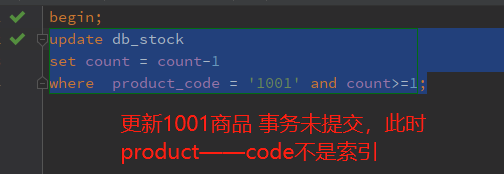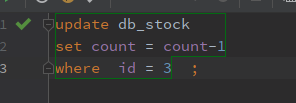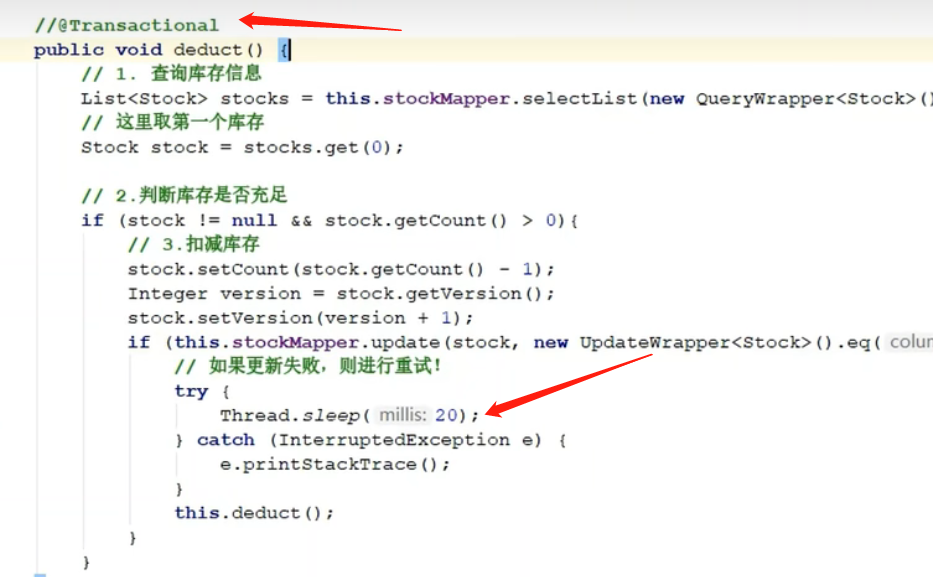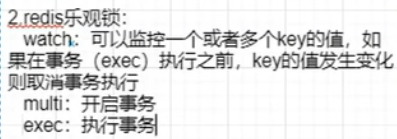读未提交解决分布式超卖
(单体项目)
读已提交的代码
@Service
public class StockServiceImpl extends ServiceImpl<StockMapper, Stock>
implements StockService{
ReentrantLock lock = new ReentrantLock() ;
@Transactional
public void deduct(){
// 上锁
lock.lock();
// 查库存 扣库存
LambdaQueryWrapper<Stock> queryWrapper = new LambdaQueryWrapper<>();
queryWrapper.eq(Stock::getProductCode,"1001") ;
Stock stock = this.getOne(queryWrapper);
if (stock!=null && stock.getCount() > 0){
System.out.println("当前库存:"+ stock.getCount());
stock.setCount(stock.getCount()-1);
this.updateById(stock) ;
}
lock.unlock();
}
}
发生超卖现象
原因: 事务2读取到事务1 未提交的数据 ,两个事务会同时读到同一个数据 ,然后减一其实只减少了一次
解决:改为 @Transactional(isolation = Isolation.READ_UNCOMMITTED),
JVM 本地锁
可以解决 多例模式 的超卖,但是不能解决 集群部署下的
Mysql锁
sql语句解决超卖问题
集群环境下
<update id="updateStock">
update demo_03.db_stock set count = count - #{count}
<where>
product_code = #{productCode}
and
demo_03.db_stock.count > #{count}
</where>
</update>
局限:
- 锁范围:选择表锁还是行级锁
- 仓库位置写死了 ,不能动态的 从不同仓库取货,而且这样会导致间隙锁(间隙锁产生的原因就是 因为按照商品code 进行更新 直接锁住了 所有的数据,导致都不能进行添加。(这里不是表锁))
间隙锁的产生原因:是索引:1. 范围更新
不是索引:1.范围更新 2. 对不是索引的字段进行更新


客户端2无法更新商品 1002,因为商品code 不是索引 ,导致间隙锁




- 无法记录其他的一些数据,例如仓库扣减记录
mysql悲观锁解决并发问题
# 查询并锁住 1001 商品 ,其他客户端无法对1001商品进行操作 for update也是一种行级锁
select * from db_stock where product_code = '1001' for update ;
@Select("select * from demo_03.db_stock where product_code = #{productCode} for update ")
List<Stock> queryStock(String productCode);
@Transactional
public void deduct(){
// 查询并且 锁定仓库
List<Stock> list = stockMapper.queryStock("1001") ;
//判空 选取并且 扣减一个仓库
Stock stock = list.get(0);
//扣减库存
if (stock!=null && stock.getCount() >0){
stock.setCount(stock.getCount()-1);
log.info("当前库:{},当前库存数量:{}",stock.getWarehouse(),stock.getCount());
this.stockMapper.updateById(stock) ;
}
}
先查询库存,然后锁定,然后 分析 ,最后减库存 。
缺点:1.加锁顺序不一样会导致死锁,1加锁 2加锁 ,1想获得2 的锁会被 阻塞
2.select for update 对一条数据进行绑定 ,就不能使用普通的select
mysql 自旋锁 解决并发问题

select version -> version = 1
update ....where version = 1

问题
1.并发量很低。更新压测失败率很高
为了确保成功 可以 递归调用该方法 或者while

取消事务注解 和 增加try cache避免递归 堆溢出,但是不停重试浪费cpu资源

2. ABA 问题 :
3. 读写分离导致乐观锁 不可靠,主从集群,由于io操作阻塞,主里面是新数据,但是从里面是旧数据。会导致并发性问题
mysql锁总结
性能:一个sql > 悲观锁 > jvm锁 > 乐观锁
如果追求极致性能、业务场景简单并且不需要记录数据前后变化的情况下。
? 优先选择:一个sql
如果写并发量较低(多读),争抢不是很激烈的情况下优先选择:乐观锁
如果写并发量较高,一般会经常冲突,此时选择乐观锁的话,会导致业务代码不间断的重试。
? 优先选择:mysql悲观锁
不推荐jvm本地锁。
redis乐观锁
redis开始事务和监听,当 别的客户端修改了数值的时候 ,此事务会执行失败
watch 机制和原理(用来监听key)
127.0.0.1:6379> watch stock1
OK
127.0.0.1:6379> multi
OK
// 此时客户端2 执行 set stock1 15
127.0.0.1:6379(TX)> set stock1 13
QUEUED
127.0.0.1:6379(TX)> exec
(nil) // 执行失败

记住 : 乐观锁就是不上锁 ,有个类似版本号的东西,这里的版本号就是来监控变化的 这里 watch自动监控了。
基本和mysql乐观锁一样的操作,但是失败率太高,失败就要重试 ,由于受最大连接数限制,你在重试,新的连接进进不来,并发量很低。
java 实现
- 这里执行需要引入回调函数
/**
* Callback executing all operations against a surrogate 'session' (basically against the same underlying Redis
* connection). Allows 'transactions' to take place through the use of multi/discard/exec/watch/unwatch commands.
*
* @author Costin Leau
*/
public interface SessionCallback<T> {
/**
* Executes all the given operations inside the same session.
*
* @param operations Redis operations
* @return return value
*/
@Nullable
<K, V> T execute(RedisOperations<K, V> operations) throws DataAccessException;
}
Executes all the given operations inside the same session.: 在一个会话里执行一些列操作
redisTemplate.execute(new SessionCallback<Object>() {
// 执行事务 + 回调
@Override
public Object execute(RedisOperations operations) throws DataAccessException {
// 具体事务
// watch
operations.watch(stockS);
// check stock1
String stockCount = operations.opsForValue().get(stockS).toString();
// multi
operations.multi();
if (stockCount!=null && stockCount.length() > 0){
int now = Integer.valueOf(stockCount).intValue();
operations.opsForValue().set(stockS , String.valueOf(--now)) ;
}
// exec
List exec = operations.exec();
// 执行事务结果集为空 是 失败,继续重试
if (exec==null || exec.size() == 0){
try {
Thread.sleep(500);
} catch (InterruptedException e) {
e.printStackTrace();
}
deduct();
}
return null;
}
}) ;
我的文章还有关于redisson 和zeepkooper 的分布式锁
zoopkeeper分布式锁
redis分布式锁
ReentrantLock 的原理
